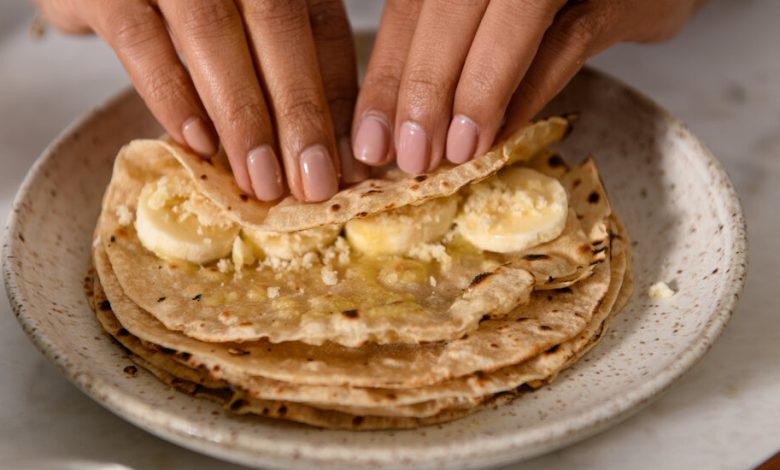Roti, a Shape-Shifting Global Staple, Takes a New Form: Convenience Food

The chef Peter Prime has been eating roti all his life. But asked to define what exactly roti is, he laughed and launched into a long-winded answer.
It could be a plain round of blistered bread, he said. Or the flaky version also known in his native Trinidad and Tobago as buss up shut. Or a floppy specimen stuffed with split peas, also known as dhal puri.
Recipe: Buss Up Shut (Paratha-Style Roti)
“We call everything roti,” said Mr. Prime with a laugh as he smeared a mixture of coconut oil and butter onto a paper-thin piece of dough in his home kitchen in Washington, D.C. It was destined to become buss up shut — or roti, depending on whom you ask.
Roti is one of the world’s most ubiquitous and shape-shifting foods, a round, unleavened bread of uncertain origin that has spread around the world, changing every time it reaches a new country, region or even household.
There are the simple wheat-flour-and-water versions found across India, the stretchy, layered variety known as roti canai in Malaysia, the shaggy roti in Guyana and the slightly chewier ones in Kenya (also known as chapati), to name just a few.
And today, roti is taking on a new role — as a convenience food.
In the United States alone, grocery shoppers can now find frozen roti of practically every variety. They can be ordered online or from enterprising cooks on WhatsApp. There’s even a machine called a Rotimatic, which sells for $1,299 and promises to turn out perfectly round roti in 90 seconds.
Roti has evolved to suit the tastes of a multitasking generation who didn’t grow up strictly eating traditional foods. For home cooks, roti can provide the base for panzanella, French toast, quesadillas, tacos or pizza.
For Mr. Prime, 52, making fresh roti “used to be a labor of love,” requiring lots of care and skill. But between work and being a parent, he doesn’t always have the time. So he relies on a frozen version sold at his local Caribbean grocery store. He’ll eat it with chana or curry beef, or slather it with peanut butter and Nutella for a snack.
Palak Patel, who runs the cooking blog the Chutney Life, turns rotli — as it is called in Gujarat, India, where her parents emigrated from — into cream cheese-filled pinwheels. She also spreads jam and butter on it, or puts it into the food processor and then mixes the resulting mash with ghee and jaggery for her 1-year-old son, Sahil.
“Being Indian American, there is such a gap and divide with my mom’s generation versus me,” said Ms. Patel, 37, who lives outside Philadelphia. Roti can be a bridge.
Granted, there are trade-offs when buying roti from a freezer case: It can be less pliable, less soft, less “melt in your mouth” than the homemade version, Ms. Patel said.
Yet the ability to buy roti rather than spending hours in the kitchen can be freeing. In India, making roti has traditionally been women’s work, said Riya Saha Shah, 45, a lawyer in Northern Virginia. “Women, before they get married, they have to make roti.” The availability of frozen roti can ease that pressure, she said.
The word roti most likely originated in the Indo-Gangetic Plain, in what is now northern India, according to Krishnendu Ray, a professor of food studies at New York University. As a result, many people assume that the food itself was born there.
But Dr. Ray said the notion of a round, unleavened bread is so basic that it’s hard to pinpoint an exact provenance.
Still, the word is used in many countries because South Asians brought their version of roti to different parts of the world through both forced and free migration. In the 19th and early 20th centuries, more than a million people were taken from the subcontinent to places like the Caribbean, Malaysia and Thailand as indentured servants working on plantations, Dr. Ray said. During the same period, other South Asians traveled to these countries freely as merchants and in other roles.
The basic recipe for roti evolved to suit the needs of each region, he said. Fat, like oil or butter, was often added to make the bread tastier and more durable. Refined flours took the place of whole-wheat flour because they were cheaper and more shelf-stable.
The word roti can now describe dozens of different preparations, and what is called a roti in Malaysia may be labeled a paratha in parts of India, or an oil roti in Guyana.
“As things and words travel,” Dr. Ray said, “they become more capacious.”
That capaciousness is one reason the chef Syd Suntha centers his Seattle food cart, Kottu, on roti. He specializes in the Sri Lankan dish called kottu roti, in which roti pieces are stir-fried with ingredients like onion and egg.
Mr. Suntha grew up on Sri Lankan fare and American snack foods in St. Louis, and his menu reflects this, incorporating seasonings like gochujang, Old Vienna Red Hot Riplets and Flamin’ Hot Cheetos in his kottu roti. When he’s preparing a large catering order and doesn’t have time to make roti in bulk, he’ll use store-bought tortillas instead.
He’s not worried about disappointing people who are seeking a more traditional version. “Those are things that taste good to me and are part of my life story,” said Mr. Suntha, 41.
The Seattle cookbook author Christina Arokiasamy, on the other hand, is looking for a traditional version when she shops for roti canai — made by stretching the dough into a thin, large round while slicking it with oil.
Ms. Arokiasamy, 55, grew up buying roti canai for a few cents from a corner shop in Kuala Lumpur, Malaysia, and eating it with tea or coffee. She cooks frozen roti canai from the South Asian grocery store on the griddle, then claps it between her hands to make it extra flaky, like the roti from her childhood.
But it’ll never taste as delicate as the fresh version, she said. “It is a lot of work and artistry to make a roti.”
Still, when roti becomes a convenience food, people who didn’t grow up with it get to try it.
A decade ago, Lola Osinkolu, 39, a food writer in Murrieta, Calif., tasted an East African roti, also known as chapati. “Immediately I fell in love with it,” she said.
She now buys the frozen version regularly, and when she doesn’t have a loaf of bread in the house, she’ll dip roti in an egg and cinnamon batter and make a variation on French toast.
Making the Indian version of roti reminded Mihaela Pacurar, 40, a freelance editor in Belmont, Mass., of palanet, the stuffed flatbreads her grandmother would make in a cast-iron stove in Romania, where Ms. Pacurar grew up.
She has since found all manner of uses for roti: rolled up with eggs and chutney for breakfast, or torn into pieces to make panzanella. She and her husband also occasionally host Passover Seder, but they don’t like matzo.
So a few years ago, they started a new Seder tradition: roti.
Follow New York Times Cooking on Instagram, Facebook, YouTube, TikTok and Pinterest. Get regular updates from New York Times Cooking, with recipe suggestions, cooking tips and shopping advice.



